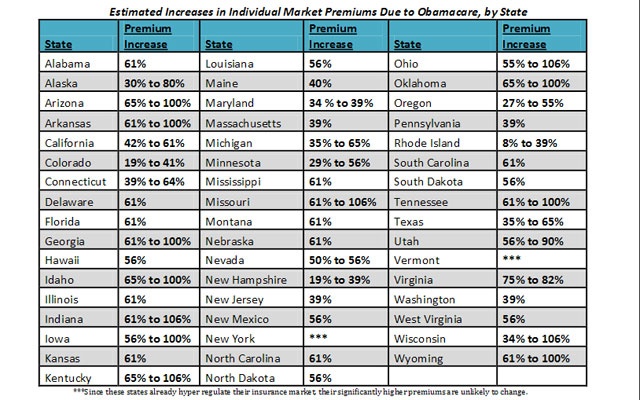Remember that repetitive presidential promise to “cut the cost of a typical family’s premium by up to $2,500 a year”? As 2014 and full implementation of Obamacare get closer, it is crystal clear that won’t be the case.
Obamacare’s most onerous insurance regulations will directly cause insurance premiums to skyrocket, particularly in the individual and small group markets.
While there are many provisions that will increase premiums, two will have the most expensive impact:
- Age rating restrictions. Obamacare limits variation in premium costs to a ratio of 3 to 1 based on age. But as Heritage research shows, “The natural variation by age in medical costs is about 5 to 1—meaning that the oldest group of (non-Medicare) adults normally consumes about five times as much medical care as the youngest group.” This means that under Obamacare, young adults will pay significantly higher premiums than they would have prior to Obamacare, and older adults will pay only slightly lower premiums.
- New benefit mandates and cost-sharing rules. Heritage expert Ed Haislmaier explains, “The new law adds a number of health care services that insurers must cover and in some cases restricts the ability of insurers and employer self-insured health plans to impose limits on the amount of services patients can consume. This combination will drive up health plan costs and premiums for both individual insurance and employer-group coverage.” In addition, Obamacare prohibits cost sharing on many preventative services, which will dramatically increase utilization of those services—pushing premiums even higher.
There have been many different studies done over the past few years to model what premium increases are likely to be under Obamacare’s new rules. The majority staff of the House Energy and Commerce Committee worked with two Senate committee staffs to compile over 30 of them to make a list of projected premium increases by state:

Source: “The Price of Obamacare’s Broken Promises,” report by the House Committee on Energy and Commerce Majority Staff, Senate Committee on Finance Minority Staff, and Senate Committee on Health, Education, Labor & Pensions Minority Staff, March 2013.
Many Obamacare advocates attempt to refute these premium increases by pointing to Obamacare’s generous subsidy scheme. But as the Hoover Institution’s Daniel Kessler points out, “This argument is misleading. It fails to consider that the money for the subsidies has to come from somewhere. Although debt-financed transfer payments may make insurance look cheaper, they do not change its true social cost.”
To that end, Obamacare’s exchange subsidies are estimated by the Congressional Budget Office to cost over $1.2 trillion over 10 years. And nobody should be surprised that this is an increase over the initial (2010) projected costs for these subsidies.
With the bulk of the health care law kicking in 2014, this is likely just the beginning of Obamacare’s broken promises.

























